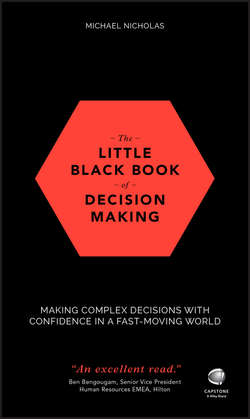Читать книгу The Little Black Book of Decision Making - Nicholas Michael - Страница 9
На сайте Литреса книга снята с продажи.
Part One
No Place for Old Dogs: New Tricks Required
1
Let's Get Real: We All Make Mistakes
First Appearances are Often Deceptive
ОглавлениеFull details of the events leading up to the Challenger disaster are a matter of public record,2 so I won't recount them in detail here. Bear in mind as you read the string of glaring errors below that this was the same organisation that achieved the incredible feat of landing men on the moon and returning them home safely, and which resolutely refused to succumb to the enormous challenges it faced in getting the stricken Apollo 13 crew back home safely when that mission suffered an oxygen tank explosion over two hundred thousand miles from Earth.
Let's return to that ill-fated Tuesday morning in January 1986. Several key facts shed light on the finding of the Rogers Commission that decision-making errors were at the heart of the catastrophe:
• The O-rings had not been designed for use at the unusually cold conditions of the morning of the launch, which was approximately -2 °C. They had never been tested below 10 °C, and there was no test data to indicate that they would be safe at those temperatures (which were around 14 °C lower than the coldest previous launch).
• NASA managers had known for almost a decade, since 1977, that the design of the shuttle's SRB's joints contained a potentially catastrophic flaw. Engineers at the Marshall Space Flight Centre had written to the manufacturer on several occasions suggesting that the design was unacceptable, but the letters were not forwarded to Morton Thiokol, the contractor responsible for construction and maintenance of the SRBs.
• Engineers raised specific warnings about the dangers posed by the low temperatures right up to the morning of the launch, recommending a launch postponement; but their concerns did not reach senior decision makers. The night before the launch, Bob Ebeling, one of four engineers at Morton Thiokol who had tried to stop the launch, told his wife that Challenger would blow up.3
• In 1985, the problem with the joints was finally acknowledged to be so potentially catastrophic that work began on a redesign, yet even then there was no call for a suspension of shuttle flights. Launch constraints were issued and waived for six consecutive flights and Morton Thiokol persuaded NASA to declare the O-ring problem “closed”.
• While the O-rings naturally attracted much attention, many other critical components on the aircraft had also never been tested at the low temperatures that existed on the morning of the flight. Quite simply, the space shuttle was not certified to operate in temperatures that low.
• It seems that one of the most important reasons why NASA staff opposed the delay may have been that the launch had already been delayed six times. Two of its managers have been quoted as saying, “I am appalled. I am appalled by your recommendation”, and “My God, Thiokol, when do you want me to launch?”4
With this broader awareness it is easy to recognise that the technical, and obvious, “cause” of the accident – the O-ring failure – was really just an outcome of the complex structural problems arising from the relationships between the parties involved. Now, I expect that the Commission's conclusion seems completely unsurprising:
Failures in communication … resulted in a decision to launch 51-L based on incomplete and sometimes misleading information, a conflict between engineering data and management judgments, and a NASA management structure that permitted the internal flight safety problems to bypass key Shuttle managers. 5
A report by the U.S. House Committee on Science and Technology went further. It agreed with the Rogers Commission on the technical causes of the accident, but was more specific about the contributing causes:
The Committee feels that the underlying problem which led to the Challenger accident was not poor communication or underlying procedures as implied by the Rogers Commission conclusion. Rather, the fundamental problem was poor technical decision-making over a period of several years by top NASA and contractor personnel, who failed to act decisively to solve the increasingly serious anomalies in the Solid Rocket Booster joints. 6
2
For the full account on Wikipedia: https://en.m.wikipedia.org/wiki/Space_Shuttle_Challenger_disaster#Liftoff_and_initial_ascent.
3
This information did not emerge until 30 years after the event:www.npr.org/sections/thetwo-way/2016/01/28/464744781/30-years-after-disaster-challenger-engineer-still-blames-himself.
4
Howard Berkes, “Remembering Roger Boisjoly: He tried to stop Shuttle Challenger launch”, 6 February 2012, www.npr.org/sections/thetwo-way/2012/02/06/146490064/remembering-roger-boisjoly-he-tried-to-stop-shuttle-challenger-launch.
5
Rogers Commission (6 June 1986), Report of the Presidential Commission on the Space Shuttle Challenger Accident, Chapter V: The Contributing Cause of The Accident.
6
U.S. House Committee on Science and Technology (29 October 1986), “Investigation of the Challenger Accident; Report of the Committee on Science and Technology, House of Representatives.”
